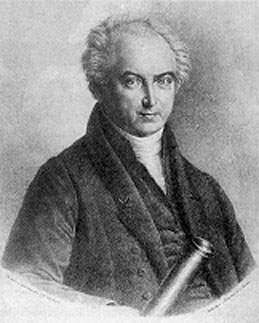| Wilhelm Olbers  AKA Heinrich Wilhelm Matthias Olbers AKA Heinrich Wilhelm Matthias Olbers
Born: 11-Oct-1758
Birthplace: Arbergen, Germany
Died: 2-Mar-1840
Location of death: Bremen, Germany
Cause of death: unspecified
Gender: Male
Race or Ethnicity: White
Occupation: Astronomer Nationality: Germany
Executive summary: Studied asteroids, comets German astronomer, born on the 11th of October 1758 at Arbergen, a village near Bremen, where his father was minister. He studied medicine at Göttingen, 1777-80, attending at the same time Kaestner's mathematical course; and in 1779, while watching by the sickbed of a fellow student, he devised a method of calculating cometary orbits which made an epoch in the treatment of the subject, and is still extensively used. The treatise containing this important invention was made public by Baron von Zach under the title Ueber die leichteste und bequemste Methode die Bahn eines Cometen zu berechnen (Weimar, 1797). A table of eighty-seven calculated orbits was appended, enlarged by Johann Franz Encke in the second edition (1847) to 178, and by Galle in the third (1864) to 242. Olbers settled as a physician in Bremen towards the end of 1781, and practiced actively for above forty years, finally retiring on the 1st of January 1823. The greater part of each night (he never slept more than four hours) was meantime devoted to astronomy, the upper portion of his house being fitted up as an observatory. He paid special attention to comets, and that of 1815 (period seventy-four years) bears his name in commemoration of its detection by him. He also took a leading part in the discovery of the minor planets, re-identified Ceres on the 1st of January 1802, and detected Pallas on the 28th of March following. His bold hypothesis of their origin by the disruption of a primitive large planet (Monatliche Correspondenz, VI, 88), although now discarded, received countenance from the finding of Juno by Harding, and of Vesta by himself, in the precise regions of Cetus and Virgo where the nodes of such supposed planetary fragments should be situated. Olbers was deputed by his fellow citizens to assist at the baptism of the king of Rome on the 9th of June 1811, and he was a member of the corps législatif in Paris 1812-13. He died on the 2nd of March 1840, at the age of eighty-one. He was twice married, and one son survived him. His unique collection of works relating to comets now forms part of the Pulkowa library. Asteroid Namesake 1002 Olbersia
Lunar Crater 7.4° N, 5.9° W (74km dia, 3km depth)
Do you know something we don't?
Submit a correction or make a comment about this profile
Copyright ©2019 Soylent Communications
|